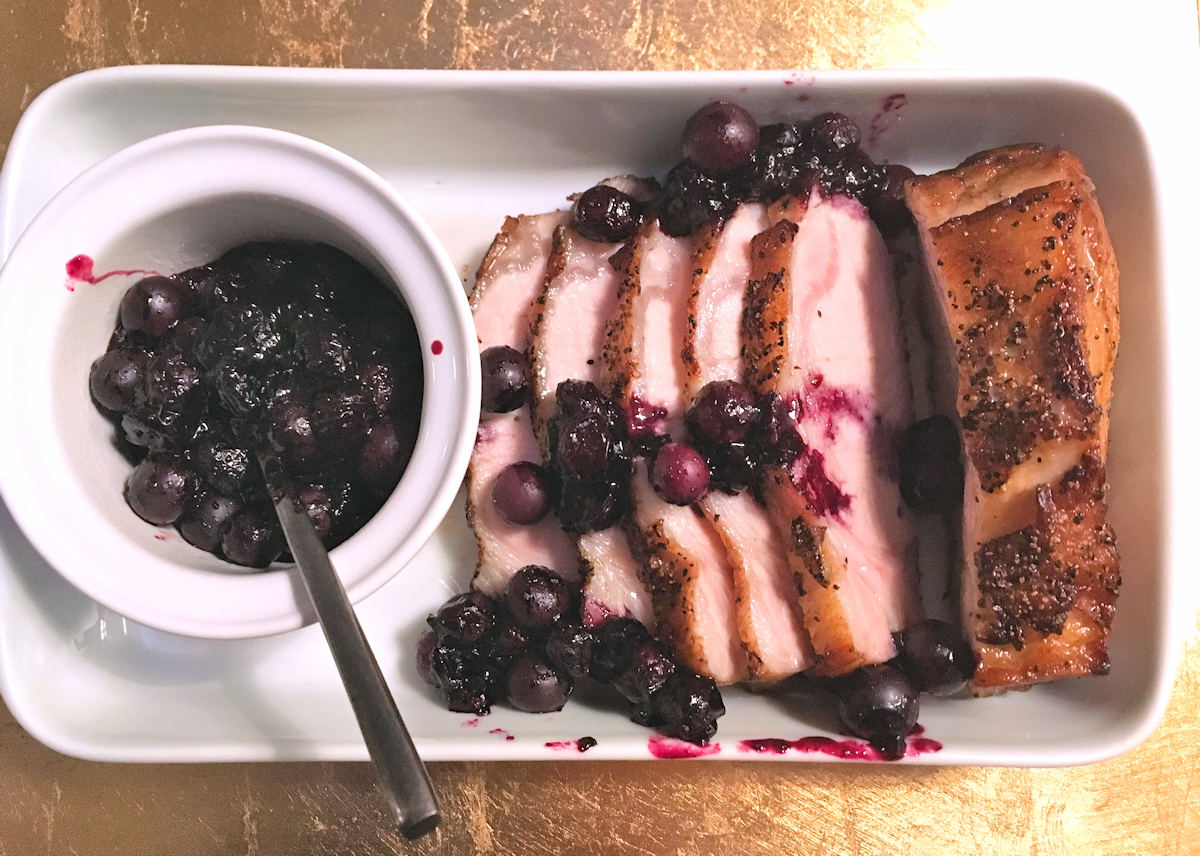Roast pork loin, unbelievably juicy and succulent, served with blueberry sauce is such a great combination I might just pair them forever now.

The best sauce for pork
The best sauce for roast pork? It isn’t parsley or apple, or even that weird condiment called bread sauce. It’s blueberry sauce, and in the form not much different than what usually hangs out in the company of pancakes.
It is silly easy to make, and you can use frozen blueberries out of season, without thawing them. Just bring all the ingredients to a rolling boil and cook for a few minutes to reduce and thicken.
Balsamic vinegar and rosemary make up the pretence of a savoury dish, but you can happily spoon any leftovers over your porridge for breakfast or even ice cream for dessert. That’s what I call a versatile condiment!
The best roast pork loin
Pork loin is usually chopped into chops rather than roasted whole. That is likely due to its lean characteristics: in simple terms, roasted pork loin tends to be rather dry.
Not this time: this is delicate lean meat, juicy and succulent, almost like cured and gently cooked ham. Taste a slice, and you might believe it’s the result of sous-vide preparation.
It is not sous-vide, but you can achieve very similar results (without the hassle of bagging up your meat and the expense of the apparatus) by low temperature roasting.
And that means low: 80C/175F.
It may seem a little hocus-pocus, out there with said sous-vide, molecular cuisine, foams and essences, but it isn’t really. Subjecting meat to gentle heat means that it doesn’t dry out, cooks very evenly and never gets to the point of being stupidly dry and frazzled – which pork loin is prone to being.
How do I know when it’s cooked?
That’s when a digital probe comes in handy, and if you haven’t got one, you’d better make the investment (not that they cost a lot these days).
Arguably the best ones can be stabbed into the meat joint going into the oven, and alert you on a remote device when a desired temperature is reached. But a pen-like thermometers will do too; you might just test the meat a couple of times before it’s ready.
In the complete absence of any kind of probe, don’t fret: the timing indicated in the recipe is pretty reliable and you can find a good guide to low-temp cooking times at Donald Russell, the esteemed Scottish online butcher.
And the best thing is, you never risk burning it, if the oven temperature is barely over medium-cooked pork!
No charred and crispy skin?
The downside of this cooking method is of course the lack of Maillard reaction – the complex process that results in humans salivating over a chunk of food (not necessarily meat).
The smell, the appearance and, in the case of my pork, a tasty-looking charred skin or fat will be utterly lacking when cooked at 80C. But that can be helped too: we have two options, either sear the meat beforehand or blowtorch it after cooking.
A chef’s blowtorch is a serious piece of kit, pricewise and operationally. A cheap blowtorch available to home cooks is fine when you want to brûlée your crème, but not enough for a roast joint.
Searing is a much safer option. Once you’ve browned your meat and it’s in the oven, you can forget about it and focus on the rest of the meal because low temp roast doesn’t need to rest. It can be sliced straight out of the (warm) oven.
Is it worth brining pork loin?
If you want to be absolutely sure the roast won’t be dry, brine the meat overnight. brining also ensures good and even seasoning and the result will be astonishing, I promise.
A simple salty-sweet brine, with whatever aromatics you like; searing the meat in a smoking-hot pan; roasting it in a barely hot oven for an hour and a half – and you and your diners will have never had such tasty roast pork before.
Does it work with pork tenderloin?
It absolutely does, and arguably there’s no need to brine pork fillet. Just season it with salt and pepper, perhaps rub it with a rosemary sprig and sear it briskly, since it’s much thinner than loin.
The roasting time will be only a quarter of an hour shorter, for one or two whole fillets.
And the blueberry sauce will go just as lovely with it.
More pork recipes
Braising is a different technique to low temperature roasting even though we sometimes refer to it as ‘slow and low’. Braised pork shoulder comes out of the oven as pulled pork, ready to be shredded into tacos.
I cannot fail to mention porchetta, Italian classic roasted pork (or, traditionally, a whole piglet!). Stuffed with herbs, rolled up and roasted, it’s the most delicious part of Italian charcuterie.
Pork and mushroom stroganoff: perfect for when you want to cook an easy but special dish and can’t afford to spend a small fortune on the ingredients.